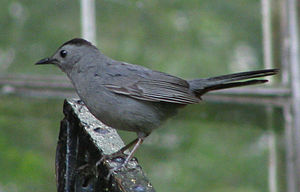Field Guide/Birds/Dumetella carolinensis
The Gray Catbird (Dumetella carolinensis) is a medium-sized perching bird of the Mimid family and the only member of genus Dumetella.
Adults are dark gray with a slim, black bill and dark eyes. They have a long dark tail, dark legs and a dark cap; they are rust-colored underneath their tail.
Their breeding habitat is semi-open areas with dense, low growth across most of North America. They are found in urban, suburban, and rural habitats. They build a bulky cup nest in a shrub or tree, close to the ground. Eggs are light blue in color, and clutch size ranges from 1-5, with 2-3 eggs most common. Both parents take turns feeding the young birds.
They migrate to the southeastern United States, Mexico and Central America. Outram Bangs and Thomas S. Bradlee (1901) described the smaller Bermudian birds, which have narrow and shorter tail feathers and primaries as bermudianus, but this species was never accepted by the A. O. U. committee on nomenclature. They were once very common in Bermuda, but their numbers have been greatly reduced in recent years by deforestation and nest predation by introduced species (including the Great Kiskadee and the European Starling). They are extremely rare vagrants to western Europe.
These birds forage on the ground in leaf litter. They mainly eat insects and berries.
In the United States, this species receives special legal protections under the Migratory Bird Treaty Act of 1918.
Song & Calls
The catbird is named for its cat-like call, but, like many members of the Mimid family, it also mimics the songs of other birds. A catbird's song is easily distinguished from that of the northern mockingbird or brown thrasher because the mockingbird repeats phrases 3-4 times, and the brown thrasher usually repeats each phrase twice, whereas the catbird sings each phrase only once. The catbird's song is usually described as more raspy and less musical than a mockingbird.
The catbird produces a variety of calls, including the familiar ones resembling a cat's meow, as well as an alarm call which resembles the quiet quacking of a male mallard.
In contrast to many songbirds which choose a prominent perch from which to sing, the catbird often chooses to sing from inside a bush or small tree, where they are obscured from view by the foliage.
The Gray Catbird is not to be confused with nor is it related to the following four bird species of the family Ptilonorhynchidae, known as bowerbirds:
- White-eared Catbird, Ailuroedus buccoides
- Spotted Catbird, Ailuroedus melanotis
- Green Catbird, Ailuroedus crassirostris
- Tooth-billed Catbird, Ailuroedus dentirostris
Interesting Catbird Facts
The syrinx of gray catbirds has an unusual structure that not only allows them to make mewing sounds like that of a cat but also allows them to imitate other birds, tree frogs, and even mechanical sounds that they hear. Their unusual syrinx also allows them to sing in two voices at once.
Gray catbirds are not afraid of predators and respond to them aggressively to them by flashing their wings and tails and by making their signature mew sounds. They are also known to even attack and peck predators that come too near their nests.
Read more About The Catbird
References
- Template:IUCN2006 Database entry includes justification for why this species is of least concern
External links
- Gray Catbird Species Account - Cornell Lab of Ornithology
- Gray Catbird - Dumetella carolinensis - USGS Patuxent Bird Identification InfoCenter
- Gray Catbird Information and Photos - South Dakota Birds and Birding
- Bermuda Online: Bermudian Fauna.
- Catbird (BirdHouses101.com)
- Life Histories of Familiar North American Birds: Gray Catbird.
be:Кашачы перасмешнік de:Katzendrossel nl:Grijze katvogel ja:ネコマネドリ

